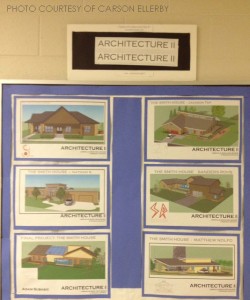
Here at Leesville there are many different electives for diverse array of interest among students. Drafting, part of the Career-Technical division is unique among electives incorporating art, technology and mathematics.
The Leesville drafting classes recently completed their chair projects. The students in the class incorporate their skills and knowledge learned from their teacher and create various 3D drawings ranging from a simple house to a chair with various technologies attached.
“This class is extremely fun, and I really love it. I love coming up with new ideas. I get my inspiration from my teacher and my fellow classmates,” said Jacob Nelson, freshman.
“This class is very cool and interesting especially if you love to design and build structures in a 3D program,” said Nathan Stafford, junior.
AutoCAD, the program that they use for the design, is a very difficult program used by many professionals. The program requires help from a teacher who is skilled in the architectural field.
Because AutoCAD is a professional program, the students receive experience in a very expensive and useful program that will allow them to expand their work and life opportunities. Autodesk, the company producing AutoCAD explains the software as this:
“The AutoCAD Design Suite includes AutoCAD, plus powerful software tools that allow you to effectively re-use old paper-based drawings, develop conceptual sketches, and showcase your designs with impact.”
“This class is teaching us a very useful skill that can be used in many forms of work,” said David Carroll, sophomore.
Drafting students who grow an interest in architecture move up to the more advanced classes.
When asked about the latest project, Mr. Robinson, drafting teacher, said, “This is what I call a convergence project. They are not just designing chairs but their incorporating a few other technologies to the chair.”
“The goal of the chair project is for the students to set a problem-solving mentality,” said Mr. Robinson.
“As long as they met their criteria which set for themselves, then the chair projects will always be successful. In the class if you come and do the work, then everyone does well.”
“Coming from Detroit, the students always laugh when I talk about Henry Ford. We need forward thinking people to look at models like Henry Ford, to strive to be the next potential innovator,” said Mr. Robinson. Progress is driven by new ideas leading to new innovations which in turn advances progresses society and improves livability.
“We need to start teaching students to think creatively and solving problems in any class,” said Mr. Robinson.
“At first, the class is pretty hard to really grasp and understand,” said Caroll. “I definitely learned that there is a lot more dynamic involved with architecture and a lot more problems to be solved than I thought.”
The process of ideation is brainstorming potential layouts for future products; the process is lengthy, however. “As designers, we have to think 10 to 20 years out, so we have to think on the horizon,” said Mr. Robinson.
“Sometimes the public doesn’t know what we need, so we’re going to need forward thinking people to solve issues that the world faces presently. Those are the type of students who will lead the future,” said Mr. Robinson.

Leave a Reply